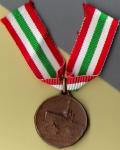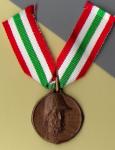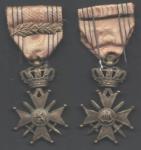-
Posts
1,116 -
Joined
-
Last visited
-
Days Won
1
Content Type
Profiles
Forums
Blogs
Gallery
Events
Store
Everything posted by Hendrik
-

Netherlands Netherlands : Badge for the Wounded
Hendrik replied to Hendrik's topic in Northern European & Baltic States
Hi Rick, The pin is indeed something to behold, almost doesn't fit in its accompanying box ! I would also recommend not wearing it on the sleeve (that was where the 'old' wound stripe went) and am under the impression that the uniform's lapel will do nicely The badge is issued ... apparently : I'm still researching it all but have come across a mention of the local town mayors presenting veterans with it. So, I'm assuming the CO's of active military personnel will perform a similar duty without those entitled being forced to open their purses. -
Gents, Received this in the mail the other day ... an attractive design, I thought. Instituted in 1990 and replacing the 'wound stripe' on the uniform's left sleeve. It is awarded to those wounded in combat in wars or international peacekeeping operations provided the wound was severe enough to need a doctor's administrations or hospitalisation. The reverse is entirely blank. [attachmentid=19852]
-
Chris, I think that is indeed the case although I haven't yet seen any official text on the subject confirming it. To my knowledge those severely wounded in combat (i.e. resulting in min. 65 % invalidity being proclaimed) would also qualify for such awards...
-
Dave, Thanks for those : very detailed info on the points' system and very useful !
-
Hallo Jens, Wie geht's ? Official ribbon devices : gilt palm : only on the 1939 cross !!! For a citation on the order of the day of the Free French Forces or on the order of the day of the nation. silver palm : replacing 5 bronze palms bronze palm : for a citation on the order of the day on army level gold star : same but on army corps level silver star : same but on division level bronze star : same but on regimental or battalion level.
-
... or you could spruce your CdG up with a fancy ribbon (combination of Military Medal, CdG and Wound Medal ribbons) or have it privately silvered ... [attachmentid=19391] [attachmentid=19392]
-
... a nice array of devices on a CdG with 1914-1917 reverse : silver palm, bronze palm, bronze star, silver star and gold star [attachmentid=19389]
-

So... whats this then ?
Hendrik replied to Chris Boonzaier's topic in Northern European & Baltic States
Ha, yes, but who awarded these ? Not the French government I think, so .. the local CO ? A similar event occured in the Belgian Navy where the Navy's Chief of Staff, on a visit to the Belgian ships on patrol during the first Gulf War, awarded a medal with a non-existing Persian Gulf bar to the crews. The medal is quite wrong for this kind of operation and the bar is up till now not officially recognized ... Shows that admirals (at least Belgian ones) do make mistakes !Oh, and there are two versions of it, a French language one and a Flemish type ! Here's the Flemish one : [attachmentid=19388] -

Netherlands Belgian WW1 Diploma...
Hendrik replied to Chris Boonzaier's topic in Northern European & Baltic States
Yes Chris, that would mean a Dutchman at birth ... I rather doubt he saw much front service : no Croix de Guerre, no front bars on the Commemorative Medal... Not sure about the document being official but I think not ... it was given in "recognition by the grateful nation" but I rather assume veterans' societies (or perhaps even an enterprising printer) were responsible for its creation. -

So... whats this then ?
Hendrik replied to Chris Boonzaier's topic in Northern European & Baltic States
The usual UN medal but with a non-official French bar is what I think. -
I've never got the gist about these bars either : there are the "geographic ones" (the Missions d'Assistance Ext?rieure being one of those) and there are the ones for "specialisation" (e.g. Troupes Aeropor?es, Infanterie, etc.). Whereas it's easy to see what the first ones are for, I have no idea what constitutes the requirements for the "specialisation" bars. Would all members of a unit qualify at the same time or is there a points system for each member to reach before he receives the bar or ... or ... ? From "Guide Pratique des D?corations Fran?aises Actuelles" : The 'M?daille de la D?fense Nationale' rewards particularly honourable services rendered by military personnel during their participation in operational activities or the army's operational preparation as well as for interventions on behalf of the population. The Bronze class is awarded for 6 months of service AND 90 points (???) - Silver class for 5 years and 600 points (and after having received the bronze class min. 2 years before) - Gold class for 10 years and 800 points (silver class min. 2 years earlier). How does a soldier get these points and would these have something to do with the specialist bars ?
-
Very interesting ! So the government created a monopoly situation for the Paris Mint and favouring the uglier designed medal ... how kind of them Here's a couple more pictures, type I silver and type II gold classes ... [attachmentid=19376] [attachmentid=19377]
-
Christophe, Now you are confusing me : a CdG award to an army unit would that consist of every unit member receiving a cross ? I thought that's what fourrag?res are for ?
-
Jacques, On those I agree with you 100 % but Klietmann does specifically insist on the Godet name on the left cross arm and the "938" on the right cross arm. I've never seen one of those that he describes, only, as in your picture, copies which include the LDO number (which Klietmann doesn't mention at all). It did sound a bit much to have the whole of the Godet name and the city of Berlin on just the one cross arm ! For the sake of completion, here's another copy (sorry for the bad picture) which is silver coloured, has "L/21" on the left and Godet etc. on the bottom cross arm. Hardly visible in the bad picture but there's "938" on the right cross arm ! The lengths those people go to to fake it (and then forgetting about the bronze finish !). Thanks for your input on this, it's nice to exchange views on such matters. [attachmentid=19195]
-
Somewhat belatedly remembering the Italian Navy has a nice website, I went and checked ... http://www.marina.difesa.it/storia/Almanacco/Parte08/Navi0836-02.htm and http://www.marina.difesa.it/storia/almanacco/parte02/navi0209-02.htm give descriptions etc. of the two ships concerned ! They both saw service in WW I. And a short search on the Pepe chap resulted in finding him to be a General that served at Marengo in Napoleon's Italian Legion ... I'm beginning to like those little medals even more now ! Ouch, a new collecting field being born ?
-
Hello Jacques, I stumbled on this remark in "Deutsche Auszeichnungen" by Dr. K.G. Klietmann : "in a few cases the manufacturer is mentioned on the reverse. Thus, as an example, on the left cross arm "J. GODET / u. SOHN / BERLIN" and on the right cross arm : "938", meaning the cross is in silver and bronze coloured." - You would disagree with this ?
-
-
The second one : Bronze medal, 33mm high (not including the suspension ring) and 24mm wide. Obverse : a shield with some drapes - top half of the rim shows a wreath, bottom half of the rim has ropes. Reverse : top text "R.N. NAPOLI" over what I think is a cruiser with "C13" under its stern. Bottom left, the initials S.J. again. [attachmentid=19175]
-
-
The number of non-official Italian medals (i.e. medals not awarded by the government but by veterans' or patriotic societies and the like) seems to be quite large. Although some are of very little interest to militaria collectors, others may be hiding an interesting background. A couple of those arrived in the mail today and I'm posting them here ... Looking forward to any information that club members may have on these. [attachmentid=19172] This first one is a bronze medal, 26mm diameter. Obverse : to the right of the unknown gentleman is the text "Nullum Opus Arduum". At 7 o'clock are the very small initials S.J. which leads me to think this medal was manufacturered by the firm of Johnson in Milano. Reverse : what appears to me to be a destroyer with "C7" under its stern. Top left is the year "MCMXV" (1915) and in the exergue "R. ESPLORATORE GUGLIELMO PEPE".
-

Yugoslavia Yugoslavian Awards
Hendrik replied to Ed_Haynes's topic in Southern European & Balkan States
Hi Gunner 1, Many thanks indeed for clearing up these points with a wealth of interesting information ! Hendrik -
Oops ! I made a mistake here : it's only 5 bronze palms that get replaced by a silver one ... Gilt palm : replacing 5 silver palms - Silver palm replacing 5 bronze palms Bronze palms are awarded for citations in the Order of the Day of the Army - Gilt, Silver and Bronze lions for resp. citations in the Order of the Day of a Division, a Brigade and a Regiment. Generally speaking, these citations would involve an act of bravoury but over the years regulations were relaxed and included many other possibilities e.g. good conduct during min. 3 years in the trenches, being invalided out because of severe war wounds, etc.
-
Skipping to WW2 ... note the royal cypher on the palm and the reverse : LIIIL with the last 'L' being mirrored on the first (King Leopold III). [attachmentid=18916]
-
-
Here's one with some 'stuff' on its ribbon ... WWI type with bronze palm and silver (!) lion device replacing 5 bronze lions. [attachmentid=18912]
















